Page 222 of 506
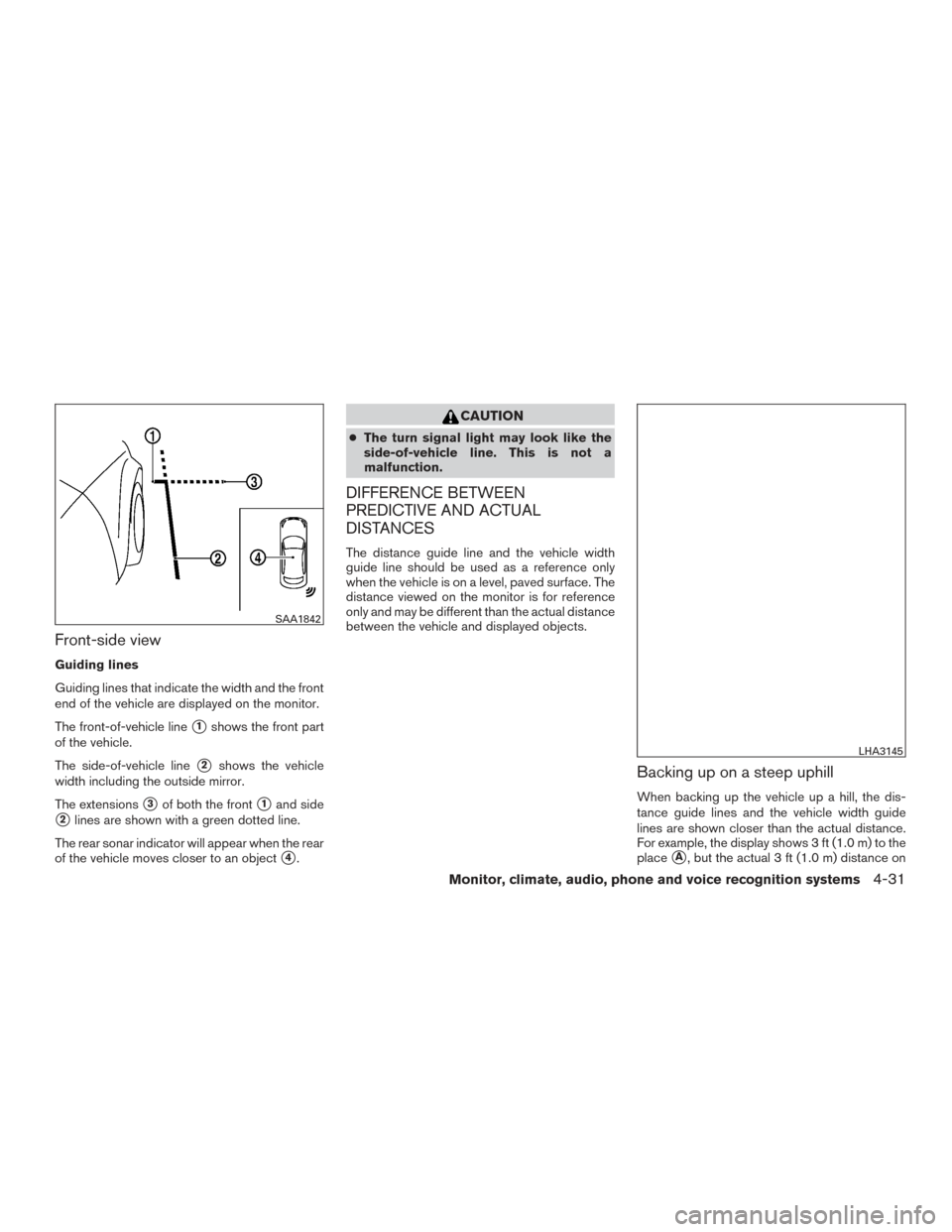
Front-side view
Guiding lines
Guiding lines that indicate the width and the front
end of the vehicle are displayed on the monitor.
The front-of-vehicle line
�1shows the front part
of the vehicle.
The side-of-vehicle line
�2shows the vehicle
width including the outside mirror.
The extensions
�3of both the front�1and side
�2lines are shown with a green dotted line.
The rear sonar indicator will appear when the rear
of the vehicle moves closer to an object
�4.
CAUTION
● The turn signal light may look like the
side-of-vehicle line. This is not a
malfunction.
DIFFERENCE BETWEEN
PREDICTIVE AND ACTUAL
DISTANCES
The distance guide line and the vehicle width
guide line should be used as a reference only
when the vehicle is on a level, paved surface. The
distance viewed on the monitor is for reference
only and may be different than the actual distance
between the vehicle and displayed objects.
Backing up on a steep uphill
When backing up the vehicle up a hill, the dis-
tance guide lines and the vehicle width guide
lines are shown closer than the actual distance.
For example, the display shows 3 ft (1.0 m) to the
place
�A, but the actual 3 ft (1.0 m) distance on
SAA1842
LHA3145
Monitor, climate, audio, phone and voice recognition systems4-31
Page 223 of 506
the hill is the place�B. Note that any object on
the hill is further than it appears on the monitor.
Backing up on a steep downhill
When backing up the vehicle down a hill, the
distance guide lines and the vehicle width guide
lines are shown farther than the actual distance.
For example, the display shows 3 ft (1.0 m) to the
place
�A, but the actual 3 ft (1.0 m) distance on the hill is the place
�B. Note that any object on
the hill is closer than it appears on the monitor.
LHA3146
4-32Monitor, climate, audio, phone and voice recognition systems
Page 224 of 506
Backing up near a projecting object
The predicted course lines�Ado not touch the
object in the display. However, the vehicle may hit
the object if it projects over the actual backing up
course. There may be a small distance visible between
the vehicle and the object in the bird-eye view on
the display�B.
Backing up behind a projecting object
The position�Cis shown farther than the position
�Bin the display. However, the position�Cis
actually at the same distance as the position
�A.
The vehicle may hit the object when backing up to
LHA1201LHA2548LHA3147
Monitor, climate, audio, phone and voice recognition systems4-33
Page 225 of 506
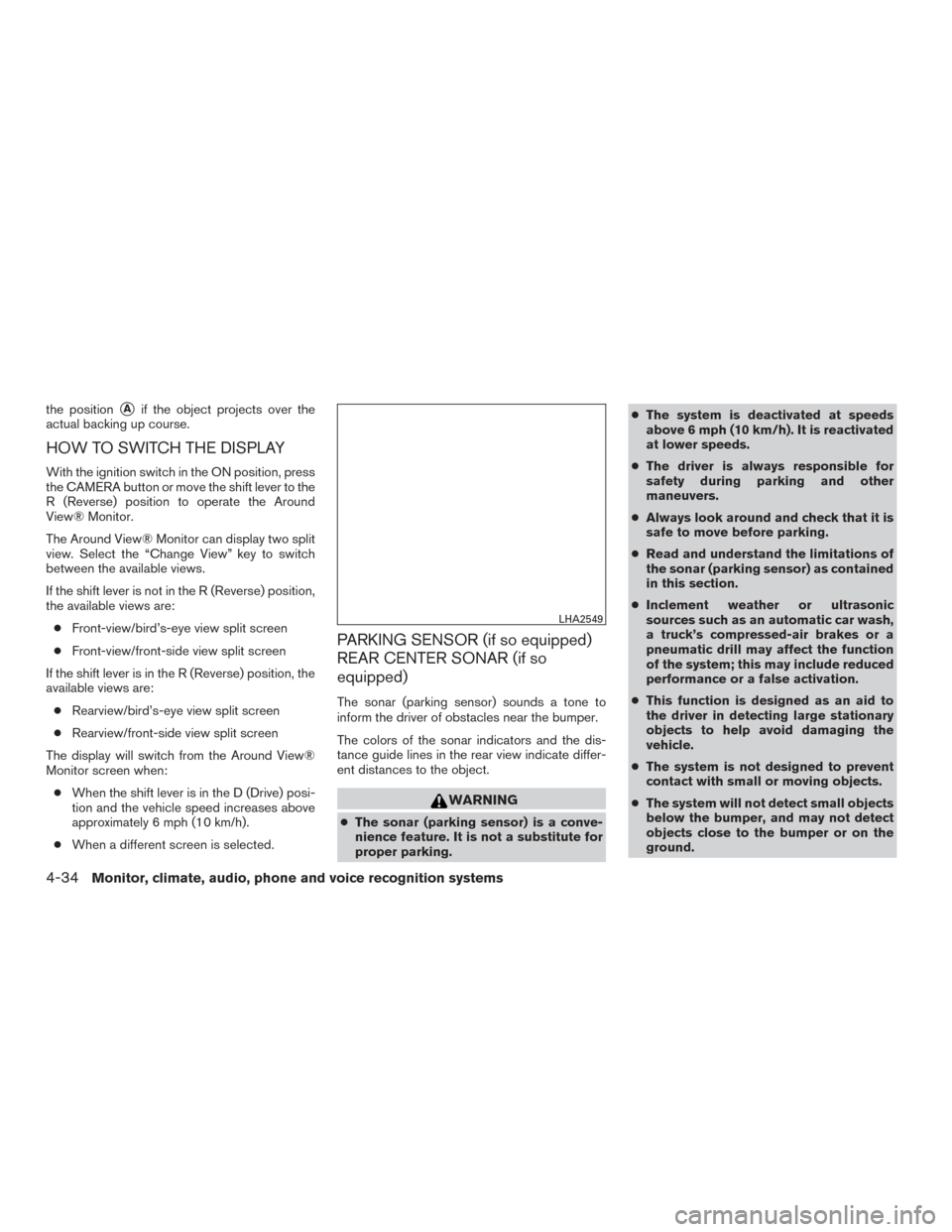
the position�Aif the object projects over the
actual backing up course.
HOW TO SWITCH THE DISPLAY
With the ignition switch in the ON position, press
the CAMERA button or move the shift lever to the
R (Reverse) position to operate the Around
View® Monitor.
The Around View® Monitor can display two split
view. Select the “Change View” key to switch
between the available views.
If the shift lever is not in the R (Reverse) position,
the available views are:
● Front-view/bird’s-eye view split screen
● Front-view/front-side view split screen
If the shift lever is in the R (Reverse) position, the
available views are: ● Rearview/bird’s-eye view split screen
● Rearview/front-side view split screen
The display will switch from the Around View®
Monitor screen when: ● When the shift lever is in the D (Drive) posi-
tion and the vehicle speed increases above
approximately 6 mph (10 km/h).
● When a different screen is selected.
PARKING SENSOR (if so equipped)
REAR CENTER SONAR (if so
equipped)
The sonar (parking sensor) sounds a tone to
inform the driver of obstacles near the bumper.
The colors of the sonar indicators and the dis-
tance guide lines in the rear view indicate differ-
ent distances to the object.
WARNING
●The sonar (parking sensor) is a conve-
nience feature. It is not a substitute for
proper parking. ●
The system is deactivated at speeds
above 6 mph (10 km/h). It is reactivated
at lower speeds.
● The driver is always responsible for
safety during parking and other
maneuvers.
● Always look around and check that it is
safe to move before parking.
● Read and understand the limitations of
the sonar (parking sensor) as contained
in this section.
● Inclement weather or ultrasonic
sources such as an automatic car wash,
a truck’s compressed-air brakes or a
pneumatic drill may affect the function
of the system; this may include reduced
performance or a false activation.
● This function is designed as an aid to
the driver in detecting large stationary
objects to help avoid damaging the
vehicle.
● The system is not designed to prevent
contact with small or moving objects.
● The system will not detect small objects
below the bumper, and may not detect
objects close to the bumper or on the
ground.
LHA2549
4-34Monitor, climate, audio, phone and voice recognition systems
Page 226 of 506
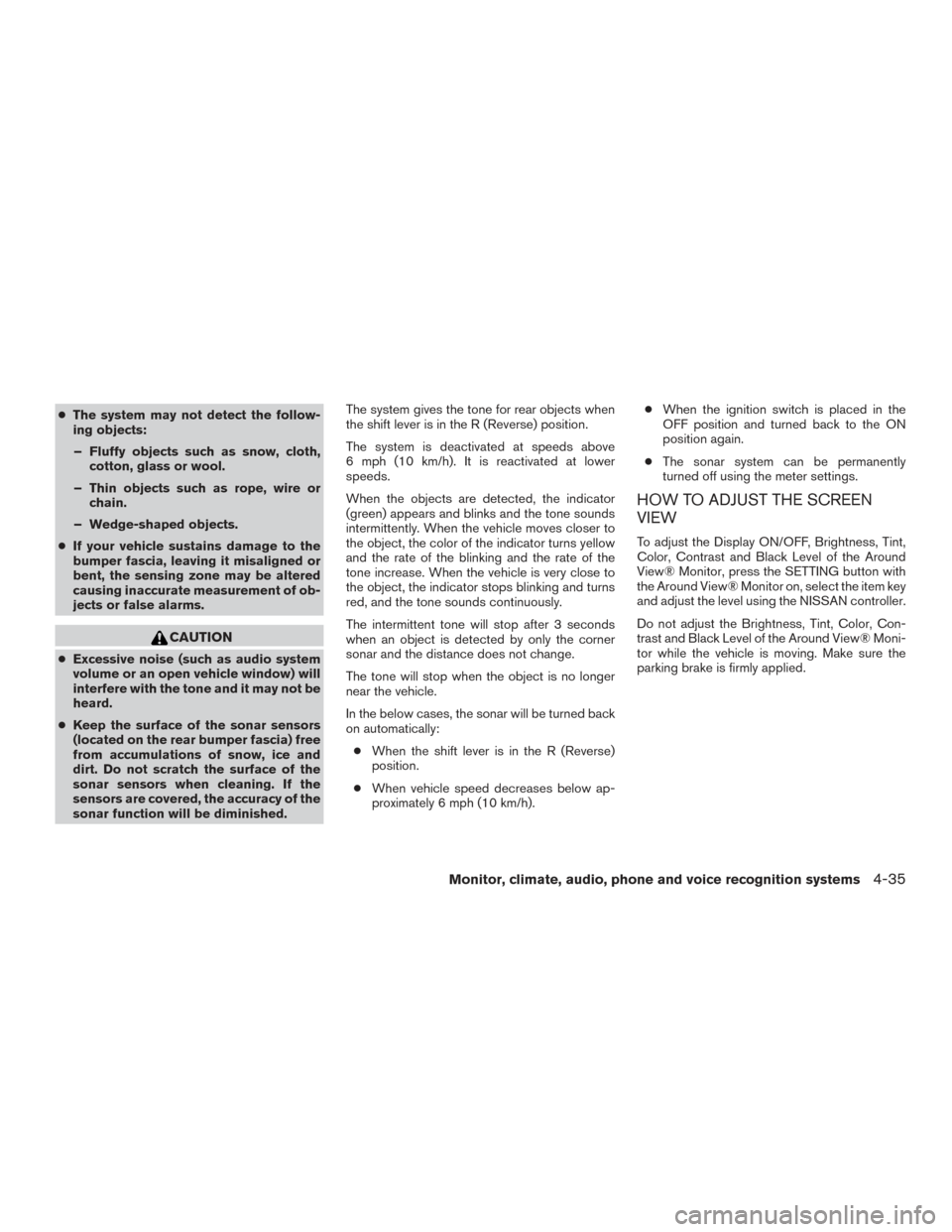
●The system may not detect the follow-
ing objects:
– Fluffy objects such as snow, cloth, cotton, glass or wool.
– Thin objects such as rope, wire or chain.
– Wedge-shaped objects.
● If your vehicle sustains damage to the
bumper fascia, leaving it misaligned or
bent, the sensing zone may be altered
causing inaccurate measurement of ob-
jects or false alarms.
CAUTION
● Excessive noise (such as audio system
volume or an open vehicle window) will
interfere with the tone and it may not be
heard.
● Keep the surface of the sonar sensors
(located on the rear bumper fascia) free
from accumulations of snow, ice and
dirt. Do not scratch the surface of the
sonar sensors when cleaning. If the
sensors are covered, the accuracy of the
sonar function will be diminished. The system gives the tone for rear objects when
the shift lever is in the R (Reverse) position.
The system is deactivated at speeds above
6 mph (10 km/h). It is reactivated at lower
speeds.
When the objects are detected, the indicator
(green) appears and blinks and the tone sounds
intermittently. When the vehicle moves closer to
the object, the color of the indicator turns yellow
and the rate of the blinking and the rate of the
tone increase. When the vehicle is very close to
the object, the indicator stops blinking and turns
red, and the tone sounds continuously.
The intermittent tone will stop after 3 seconds
when an object is detected by only the corner
sonar and the distance does not change.
The tone will stop when the object is no longer
near the vehicle.
In the below cases, the sonar will be turned back
on automatically:
● When the shift lever is in the R (Reverse)
position.
● When vehicle speed decreases below ap-
proximately 6 mph (10 km/h). ●
When the ignition switch is placed in the
OFF position and turned back to the ON
position again.
● The sonar system can be permanently
turned off using the meter settings.
HOW TO ADJUST THE SCREEN
VIEW
To adjust the Display ON/OFF, Brightness, Tint,
Color, Contrast and Black Level of the Around
View® Monitor, press the SETTING button with
the Around View® Monitor on, select the item key
and adjust the level using the NISSAN controller.
Do not adjust the Brightness, Tint, Color, Con-
trast and Black Level of the Around View® Moni-
tor while the vehicle is moving. Make sure the
parking brake is firmly applied.
Monitor, climate, audio, phone and voice recognition systems4-35
Page 227 of 506
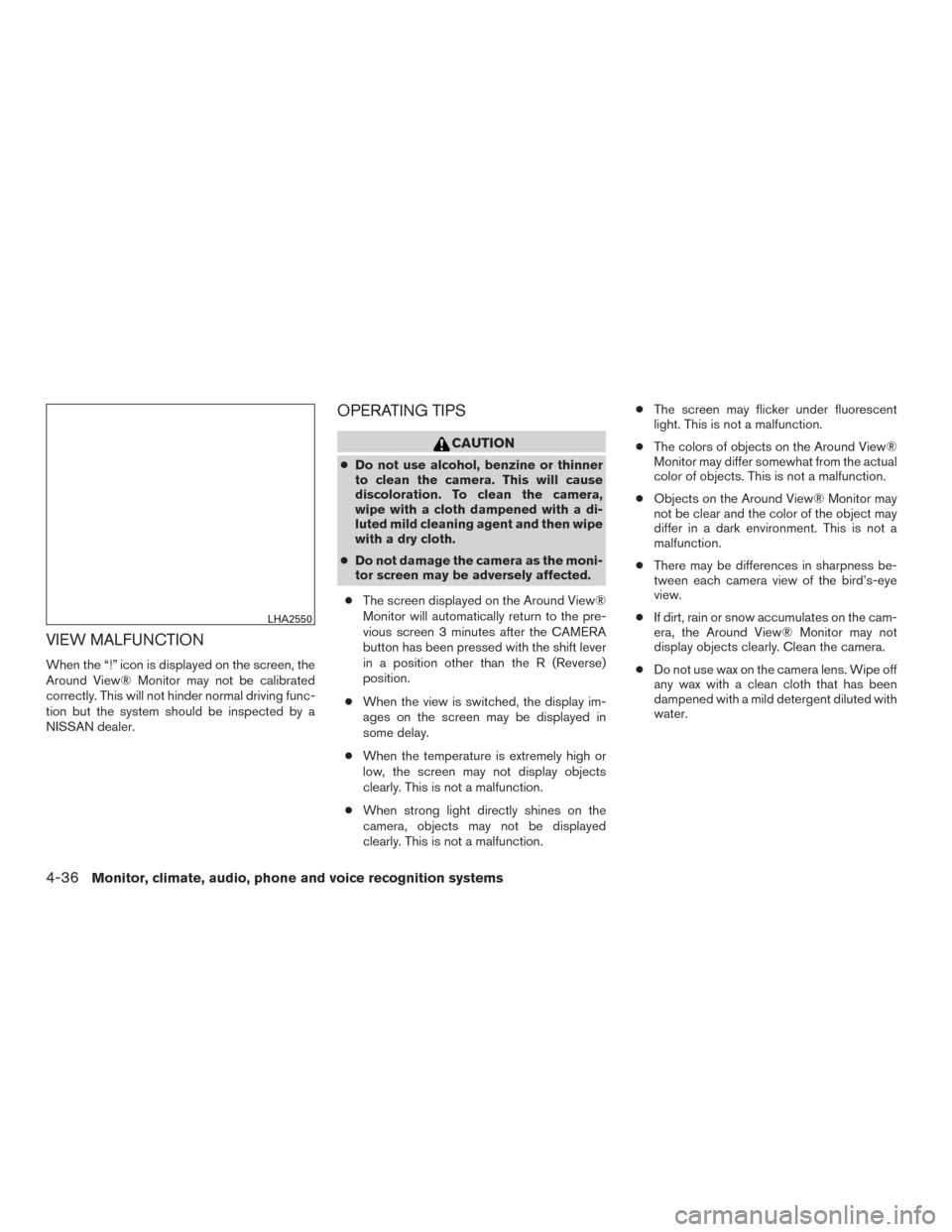
VIEW MALFUNCTION
When the “!” icon is displayed on the screen, the
Around View® Monitor may not be calibrated
correctly. This will not hinder normal driving func-
tion but the system should be inspected by a
NISSAN dealer.
OPERATING TIPS
CAUTION
●Do not use alcohol, benzine or thinner
to clean the camera. This will cause
discoloration. To clean the camera,
wipe with a cloth dampened with a di-
luted mild cleaning agent and then wipe
with a dry cloth.
● Do not damage the camera as the moni-
tor screen may be adversely affected.
● The screen displayed on the Around View®
Monitor will automatically return to the pre-
vious screen 3 minutes after the CAMERA
button has been pressed with the shift lever
in a position other than the R (Reverse)
position.
● When the view is switched, the display im-
ages on the screen may be displayed in
some delay.
● When the temperature is extremely high or
low, the screen may not display objects
clearly. This is not a malfunction.
● When strong light directly shines on the
camera, objects may not be displayed
clearly. This is not a malfunction. ●
The screen may flicker under fluorescent
light. This is not a malfunction.
● The colors of objects on the Around View®
Monitor may differ somewhat from the actual
color of objects. This is not a malfunction.
● Objects on the Around View® Monitor may
not be clear and the color of the object may
differ in a dark environment. This is not a
malfunction.
● There may be differences in sharpness be-
tween each camera view of the bird’s-eye
view.
● If dirt, rain or snow accumulates on the cam-
era, the Around View® Monitor may not
display objects clearly. Clean the camera.
● Do not use wax on the camera lens. Wipe off
any wax with a clean cloth that has been
dampened with a mild detergent diluted with
water.
LHA2550
4-36Monitor, climate, audio, phone and voice recognition systems
Page 228 of 506
Adjust air flow direction for the center vents�1,
driver’s and passenger’s side vents
�2, and rear
vents
�3by moving the vent slide and/or vent
assemblies. Open or close the vents using the dial. Move the
dial toward theto open the vents or toward
the
to close them.
LHA2480
VENTS
Monitor, climate, audio, phone and voice recognition systems4-37
Page 229 of 506
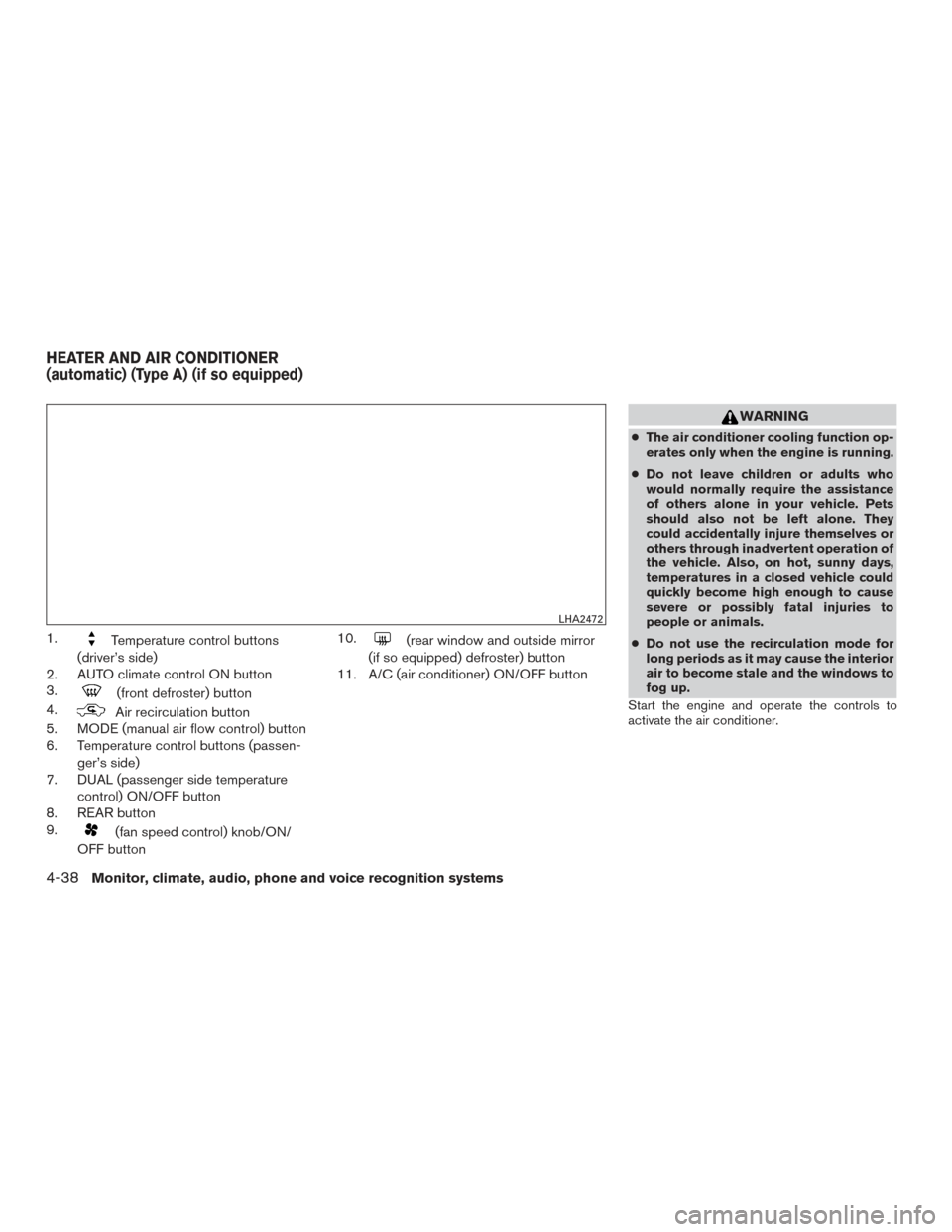
1.Temperature control buttons
(driver’s side)
2. AUTO climate control ON button
3.
(front defroster) button
4.
Air recirculation button
5. MODE (manual air flow control) button
6. Temperature control buttons (passen-
ger’s side)
7. DUAL (passenger side temperature
control) ON/OFF button
8. REAR button
9.
(fan speed control) knob/ON/
OFF button 10.
(rear window and outside mirror
(if so equipped) defroster) button
11. A/C (air conditioner) ON/OFF button
WARNING
● The air conditioner cooling function op-
erates only when the engine is running.
● Do not leave children or adults who
would normally require the assistance
of others alone in your vehicle. Pets
should also not be left alone. They
could accidentally injure themselves or
others through inadvertent operation of
the vehicle. Also, on hot, sunny days,
temperatures in a closed vehicle could
quickly become high enough to cause
severe or possibly fatal injuries to
people or animals.
● Do not use the recirculation mode for
long periods as it may cause the interior
air to become stale and the windows to
fog up.
Start the engine and operate the controls to
activate the air conditioner.
LHA2472
HEATER AND AIR CONDITIONER
(automatic) (Type A) (if so equipped)
4-38Monitor, climate, audio, phone and voice recognition systems